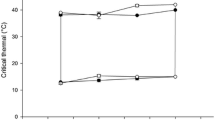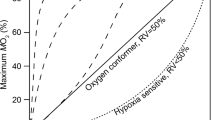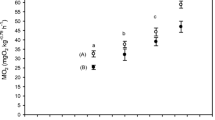Abstract
Oxygen consumption is oftentimes used as a proxy for metabolic rate. However, pupfish acclimated to ecologically relevant temperatures may employ extended periods of anaerobism despite the availability of oxygen—a process we called paradoxical anaerobism. In this study, we evaluated data from pupfish exhibiting stable oxygen consumption. Routine oxygen consumption (\({R_{V{{\text{O}}_{\text{2}}}}}\)) of a refuge population derived from Cyprinodon spp. acclimated to 28 and 33 °C was evaluated at the ecologically relevant assay temperatures of between 25 and 38 °C. Different interpretations of the data are available depending on normalization. For instance, \({R_{V{{\text{O}}_{\text{2}}}}}\) of smaller fish, measured per fish, was remarkably stable over a wide range of assay temperatures and was not different between acclimation groups. However, when measured on a mass-specific basis, \({R_{V{{\text{O}}_{\text{2}}}}}\) in these same smaller fish increases more predictably as temperature increased. \({R_{V{{\text{O}}_{\text{2}}}}}\) of refuge fish and the closely related pupfish, C. nevadensis mionectes, measured near their respective acclimation temperatures, were essentially identical. However, \({R_{V{{\text{O}}_{\text{2}}}}}\) of 28 °C acclimated fish of both species, when measured at 34 °C, was greater than that of the 33 °C acclimated fish measured at 28 °C. We suggest that this observed ‘efficiency’ may result from significant anaerobic metabolism use. Experiments investigating factorial aerobic scope (\({\text{Ma}}{{\text{x}}_{V{{\text{O}}_{\text{2}}}}}\)/\({R_{V{{\text{O}}_{\text{2}}}}}\)) yielded values less than 1 in 21–36% of the 33 °C acclimated fish. These values indicate a substantial contribution of anaerobic metabolism to energy utilization by these fish. However, muscle lactate levels are not elevated in exercising fish—a result that is consistent with paradoxical anaerobism use.







Similar content being viewed by others
References
Arrhenius S (1889) Über die reaktionsgeschwindigkeit bei der inversion röhrzucker dürch säuren. Z Phys Chem 4:226–248
Beamish FWH (1964) Respiration of fishes with special emphasis on standard oxygen consumption: II. Influence of weight and temperature on respiration of several species. Can J Zool 42:177–188
Chung DJ, Schulte PM (2015) Mechanisms and costs of mitochondrial thermal acclimation in a eurythermal killifish (Fundulus heteroclitus). J Exp Biol 218:1621–1631
Deacon JE, Taylor FR, Pedretti JW (1995) Egg viability and ecology of Devils Hole pupfish: insights from captive propagation. Southwest Nat 40:216–223
Ejbye-Ernst R, Michaelsen T, Tiersgaard B, Wilson JM, Jensen LF, Steffensen JF, Pertoldi C, Aerstrup K, Svendsen JC (2016) Partitioning the metabolic scope: the importance of anaerobic metabolism and its implications for the oxygen-and-capacity-limited thermal tolerance (OCLTT) hypothesis. Cons Physiol 4:cow19 (conphys.oxfordjournals.org)
Fangue NA, Mandic M, Richards JG, Schulte PM (2008) Swimming performance and energetics as a function of temperature in killifish Fundulus heteroclitus. Physiol Biochem Zool 81:389–401
Goolish EM (1991) Aerobic and anaerobic scaling in fish. Biol Rev 66:33–56
Healy TM, Schulte PM (2012) Thermal acclimation is not necessary to maintain a wide thermal breadth of aerobic scope in the common killifish (Fundulus heteroclitus). Physiol Biochem Zool 85:107–119
Heuton M, Ayala L, Burg G, Dayton K, McKenna K, Morante A, Puentadura G, Urbina N, Hillyard S, Steinberg S, van Breukelen F (2015) Paradoxical anaerobism in desert pupfish. J Exp Biol 218:3739–3745
Hillyard SD (2011) Life in hot water, the desert pupfish. In: Farrell AP, Stevens D (eds) Encyclopedia of fish physiology, from genome to environment. Academic Press, London
Hochachka PW, Somero GN (2002) Biochemical adaptation, mechanisms and process in physiological evolution. Oxford University Press, New York
Hoss DE (1967) Rates of respiration of estuarine fish. Proc A Conf SE Assoc Game Fish Commun 21:416–423
Jones AC, Lim D, Wayne-Thompson JJ, Urbina N, Puentedura G, Hillyard S, van Breukelen FV (2016) Oxygen consumption is limited at an ecologically relevant rearing temperature in pupfish eggs. J Exp Zool A Ecol Genet Physiol 325:539–547
Martin AP, Echelle AA, Zegers G, Baker S, Keeler-Foster CL (2012) Dramatic shifts in the gene pool of a managed population of an endangered species may be exacerbated by high genetic load. Conserv Genet 13:349–358
McGaw IJ, Curtis DL, Ede JD, Ong KJ, van Breukelen F, Goss GG (2009) Physiological responses of postprandial red rock crabs (Cancer productus) during emersion. Can J Zool 87:1158–1169
Nordlie FG (2014) Influences of body mass, temperature, oxygen tension, and salinity on respiratory oxygen consumption of cyprinodontid fishes of three families. Rev Fish Biol Fish 24:269–315
Randall D, Burggren W, French K (2002) Eckert animal physiology mechanisms and adaptations. W.H. Freeman, New York
Regan MD, Gosline JM, Richards JG (2013) A simple and affordable calorespirometer for assessing the metabolic rate of fishes. J Exp Biol 216:4507–4513
Stuenkel EL, Hillyard SD (1981) The effect of temperature and salinity acclimation on metabolic rate and osmoregulation in the pupfish Cyprinodon salinus. Copeia 1981:411–417
Targett TE (1978) Respiratory metabolism of temperature acclimated Fundulus heteroclitus (L.): zones of compensation and dependence. J Mar Biol Ecol 32:197–206
Vaishnavi SN, Vlassenko AG, Rundle MM, Snyder AZ, Mintun MA, Raichle ME (2010) Proc Nat Acad Sci 107:17757–17762
Withers PC (1992) Comparative animal physiology. Saunders College Pub., Philadelphia
Acknowledgements
We thank the various regulatory and permitting agencies for facilitating this work. In particular, Sean Harris from NDOW was instrumental in initiating this project. Lee Simons from USFWS was very supportive of these projects.
Funding
This work was funded by Grants from University of Nevada Las Vegas, the US Fish and Wildlife Service (USFWS), the Nevada Department of Wildlife (NDOW), and the National Science Foundation Nevada Experimental Program to Stimulate Competitive Research (EPSCoR).
Author information
Authors and Affiliations
Corresponding author
Ethics declarations
Conflict of interest
The authors declare no competing interests or conflicts of interest.
Additional information
Communicated by G. Heldmaier.
Rights and permissions
About this article
Cite this article
Heuton, M., Ayala, L., Morante, A. et al. Oxygen consumption of desert pupfish at ecologically relevant temperatures suggests a significant role for anaerobic metabolism. J Comp Physiol B 188, 821–830 (2018). https://doi.org/10.1007/s00360-018-1174-1
Received:
Revised:
Accepted:
Published:
Issue Date:
DOI: https://doi.org/10.1007/s00360-018-1174-1




